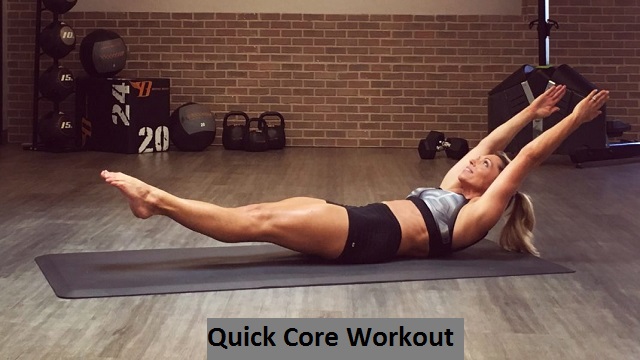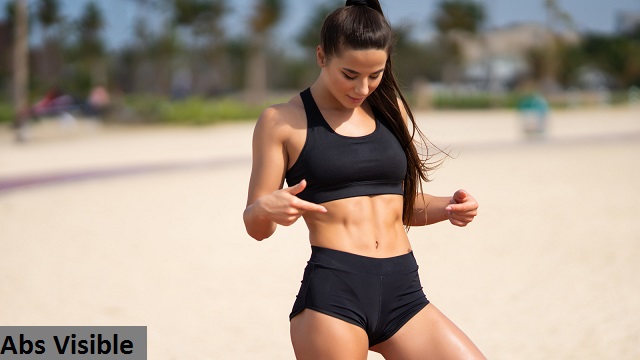
15 minutes is all it takes to complete this quick core exercise at home.
Quick core exercises should use simple, direct movement patterns. You don’t need to perform hours of abdominal exercises to develop six-pack abs or a stronger midsection, and you don’t need expensive equipment or a lot of crunches either.
All you need is about 15 minutes, some upbeat music, possibly some padding, and a positive outlook. Intensity is the secret to this at-home, 15-minute quick core workout.
What Constitutes Your Core?
Your midsection, also referred to as your core, is comprised of your upper body’s front, back, and sides. The transverse abdominis (TVS), erector spinae, obliques, and lower lats are also part of the core in addition to your six-pack.
Having this area appear ripped, trim, and lean is definitely ideal. The core, though, is more than just visually appealing. Your skeletal system is supported by a strong core, which keeps your spine stable and aids in injury prevention, allowing you to move freely and with good posture.
How Should You Make the Most of Your Quick 15-Minute Core Workout?
You can: when performing an efficient core exercise at home.
- Go anywhere.
- Use little or no equipment to accomplish.
- can perform with purpose and intensity.
- Activates the Whole Core Section.
The following can be done daily, every other day, or 2-3 times per week. Additionally, you can perform it as a stand-alone workout coupled with some mobility work, with some cardio for a powerful burn, or at the conclusion of a lifting session.
Intensity, form, and purpose are prioritized for a predetermined period of time with a built-in rest instead of reps.

How Can I Make My Abs Visible?
It goes without saying that in order to get stronger and avoid injuries, you should have a great ab routine like this quick core workout that you can do at home in just 15 minutes. Rep after rep and workout after workout won’t actually give you visible abs if that’s your goal, so what’s the secret? Sure, your abs will be stronger, but they probably won’t be visible.
It’s time to consider what you do with your body during the other 23 hours of the day if you want to achieve visible abs. You must be doing something incorrectly if you consistently get the same results from workout to workout and still can’t see your abs. A nutritionist can help with this.
Having a coach takes the guesswork out of nutrition for you, allowing you to achieve the strong, svelte, and shredded physique you’ve always wanted in addition to increasing strength and performance.
The Quick Core Exercise You Can Perform At Home:
You will practice an EMOM structure (every minute on the minute) for the duration of this workout. There is an automatic 15-second rest period built into the movement, which starts at the top of the minute and lasts for 45 seconds. Take advantage of it because you’re going to feel the BURN after this quick 15-minute core workout!
As an illustration:
- 0:00 – start.
- 0:45 – rest.
- 1:00 – start.
- 1:45 – rest.
for the next fifteen minutes.
What Characterizes a Good Abs Workout?
All of the major areas as well as performance will be the focus of an efficient ab workout. There will be five exercises in total in this workout. The first one works your upper abs, which are involved in bending forward.
Next, a lower-abdominal exercise that encourages lifting the legs will be performed. Then, since the obliques are involved in twisting and bending, we’ll do something for them.
Stabilization and balance follow after that. This is frequently overlooked during ab exercises, but not here. Because of this, we have also added a plank. Last but not least, having a smaller waist is a common objective for athletes and fitness enthusiasts.
So to help with that, we’ll wrap up with an antiquated movement. In the MandS Exercise Video Database, you can find videos of each of these movements. We’ll also include a few pointers that should enable you to maximize the quarter-hour you have available for this.
Sit ups work the upper abs.
Most likely, one of the first exercises you learned in elementary school was the sit-up. Even though it’s basic, it still functions. Going all the way up will benefit both appearance and performance. The crunch is thought to be a more well-liked option because it is supposed to isolate the upper abs more.
The other criticism leveled against sit-ups is that, due to the feet being hooked, they will work the hip flexors. The hips will definitely join the party if you lift your toes up and use the anchor holding your feet as leverage.
The hips won’t be nearly as active if you keep your feet flat and focus on tightening your abs.
Hold a weight plate or weighted ball against your chest if you feel that your body weight is insufficient or if you really want to concentrate on strength. If you’d prefer to only use your body weight, then continue to squeeze your abs for a few more seconds while lowering yourself down very slowly.
Before starting the second exercise, complete 15 repetitions of the first one. Fortunately, transitioning will be fairly easy.
Alternate Straight Leg Lower: Lower Abs.
The standard exercise for exercising the lower abs is the lying leg raise. Although it is effective, there is a better approach that can also aid in fostering balance.
The exercise is a little more difficult when performed with one leg at a time.Additionally, it can help you become more flexible because you have to keep the non-working leg lowered while using the working leg.
There is a way to make this one more captivating. Either complete all the reps for one leg before moving on to the other, or alternate legs until all the sets are complete. In any case, you’ll perform 15 repetitions per leg.
Leg ankle weights should be worn if becoming stronger is important to you. To keep your core in a tight position, you can also pause before touching the floor with the leg that isn’t being used.

Move 1 of the Quick Core Workout is Mountain Climber.
The plank position serves as the movement’s focal point. Mountain climbers, which imitate a running position, not only work your abs but also your entire body while raising your heart rate. The abdominals, biceps, chest, deltoids, hamstrings, hip abductors, obliques, quads, and triceps are among the muscles that are worked.
How Should I Work My Abs Like A Mountain Climber?
- Start by inhaling deeply, activating your core, and lowering yourself into a high-plank/push-up position.
- Put your fingers into the ground, stack your shoulders over your elbows and over your hands, and slowly bring one knee into your chest so that it looks like a high knee before straightening it back out to the side.
- Decide on a comfortable working speed by repeating the exercise with the other leg.
- For the duration of the 45-second working window, execute this movement as quickly as you can while maintaining control while maintaining a neutral spine and your gaze on the floor.
- Remember to breathe!

Side plank is Quick Core Workout Move 2.
The side plank is special because it targets muscles that aren’t targeted by other ab exercises like crunches or toe touches. In addition to working the deep lower back muscles (also known as the quadratus lumborum, the backside of the abdominal wall that plays a significant role in preventing back pain), this killer core position also works the deltoids, obliques, and the legs from heel to hip.
There are numerous modifications available in case they are required due to the fact that this movement can be quite difficult. We advise choosing a position that you can hold throughout the entire quick core workout and advancing week after week as you gain strength.
How Should You Do A Side Plank?
- Put yourself on your side on the ground and start there.
- Depending on the modification you are making, position one hand on your hips so it is out of the way and the other hand is placed directly underneath your shoulder.
- Breathe deeply and start by raising the hips off the floor. As a modification, you can either lift both hips and knees while keeping one or both knees on the floor, or you can lift both while using your feet and toes to root into the ground.
- Make sure your gaze is forward and that your head isn’t “hanging” or too tense by pulling it up toward the shoulder; this will help the spine stay neutral through the cervical region.
- Pulling yourself straight up off the ground, your body should be firm and tense from head to toe.
- Depending on your strength and ability, you can keep the opposite arm extended laterally overhead, in front of you, or up above you.
- The following time the movement appears in your 15-minute quick core workout sequence, hold for 45 seconds and then focus on the opposite side.

Alternating V-Ups is the third quick core exercise move.
Alternating V-ups, also known as Jackknife Sit-Ups or Pike Crunches, isolate the abdominal region while working the entire core. If you want to alter the movement, keep your arms at your sides and press into the ground with one while reaching up with the other.
Alternatively, you can keep your feet flat on the ground and your knees bent while extending your alternating leg to meet your opposing arm.
Alternating V-Ups: What Should I Do?
- Lay backwards with your back pressed firmly against the ground.
- For stability and balance, if necessary, the arms should be at your sides with the palms of your hands facing the floor.
- Lift one leg into the air while lowering one arm slowly to meet the knee, shin, ankle, or toe.
- Squeeze your glutes and push your belly button to the floor.
- Maintaining the heels 3 to 6 inches off the ground throughout the movement will make it harder.
Note: It’s crucial to maintain a neutral spine and to look up at the ceiling in order to prevent the neck and chin from collapsing.
Read More: 8 fundamental kettlebell movements
Leave a Reply